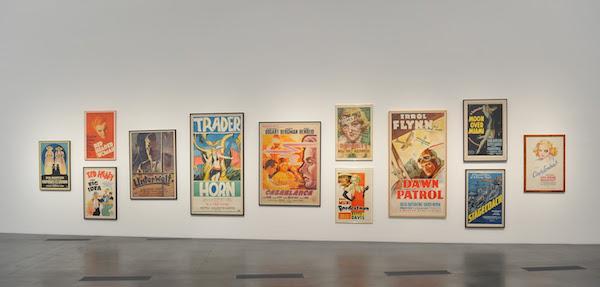On Saturday, February 24, LACMA will unveil The Art of the Movie Poster: Highlights from the Mike Kaplan Collection, which will be prominently displayed at the entrance to the Ahmanson Building.
This significant new exhibition explores the film poster as an art form, one that encompasses a wide range of styles, designs, and subjects. On view will be more than 20 rare posters, most of which have never been displayed at a major art museum. This installation will take place in two parts, the first from February 24 through April 29 and the second from May 12 through August 26, 2018.
This selection of international posters from the Golden Age of movie poster design (1920–1950) celebrates the bravura, charm, and inventiveness of these spectacular images. Deliberately chosen for the impressive quality of their design, these posters exemplify the high achievements of artists and illustrators in the era before photography dominated the field.
The art of film is multi-faceted. In addition to producing theatrical features, the movie industry generated many types of objects to promote them: trailers, stills, lobby cards, and fan magazines. Amid this panoply of film-related material, posters have often achieved the status of art. When adroitly executed and imbued with narrative flair, they carry a charge and fascination all their own. In the words of Los Angeles Times critic Kenneth Turan, great movie posters from the Golden Age are “snapshots of cinema, intense jolts of visual stimulation that convey the focused essence of a cinematic experience.”
Poised at the frontier between high art and popular culture, movie posters are emblematic of modernity itself. On the one hand, they often deployed the most avant-garde formal and typographic trends of a given period, demonstrating true compositional innovation. On the other, they were advertisements, intended to stand out in the visual cacophony of the modern city and to attract the broadest possible audiences. Many people received an education in modern art and design history from movie posters, which are an essential link between fine-art practices and their distillation in everyday life.
According to Mike Kaplan, whose collection is founded on design, an ideal movie poster "captures graphically the creativity and emotion of the film-going experience" in a single image, while at the same time standing alone as a work of art and a souvenir of that experience. A designer, art director, and producer (The Whales of August, I’ll Sleep When I’m Dead) Kaplan has first-hand experience in crafting campaigns and posters, the most famous among them A Clockwork Orange (1971) and "The Ultimate Trip/StarChild" campaign for the re-launch of 2001: A Space Odyssey in 1970. David Hockney, Don Bachardy, Allen Jones, John Van Hamersveld, Andre Carillho, and British airbrush maven Philip Castle are among the artists and illustrators with whom he has collaborated. He is also a connoisseur of poster design history, gravitating toward exceptional illustrators, motifs, studio periods, national styles, stars, directors, and film genres.
The selections span film genres and artistic styles, from the great caricaturist Al Hirschfield’s playful rendering of The Three Stooges for The Big Idea (1934) and, in part two, of the Marx Brothers for A Night At The Opera (1935) to the dramatic realism of the three-sheet poster for the Errol Flynn World War I film The Dawn Patrol (1938). An elegant poster for the French release of Casablanca (1947), designed by leading artist Pierre Pigeot, demonstrates how the classic film was promoted abroad. The shadowy German design for director Josef Von Sternberg’s Underworld (1927, poster dated 1928) captures the dark mood of the pioneering gangster film. Two stunning images are from America: an intense Bette Davis in Bordertown (1935) and movie queen Constance Bennett in What Price Hollywood (1932), where her private life is headlined across her face.
The second grouping emphasizes the international scope of Kaplan’s collection, featuring rare works from Sweden, Austria, and France as well as the United States. Foreign depictions of Hollywood legends, such as the towering portrayals of Joan Crawford, Clark Gable, and Robert Montgomery in the Austrian posters for Forsaking All Others (1934) and of Edward G. Robinson and Loretta Young in The Hatchet Man (1932) reveal how their celebrity transcended borders. Swedish designs, which in Kaplan’s words, “look as modern today as they did 90 years ago,” are represented by designer Moje Åslund’s streamlined, futuristic image for Things To Come (1936) and the vibrant poster for Harold Lloyd’s comedic Grandma’s Boy (1922). Actor, singer, and activist Paul Robeson has five transformations in the poster for his most famous film, Emperor Jones (1933). And the striking French poster for Maltese Falcon (1941) brings together the iconic faces of stars Humphrey Bogart, Mary Astor, and Peter Lorre across the back of the eponymous bird.
“These vintage images are rare totems,” Kaplan says, “as far away from today’s movie posters as one could imagine.”
In recent years LACMA has been expanding its programming to recognize the role of film as one of the key art forms of the 20th and 21st centuries. In 2014, we launched a graphic design initiative to develop the museum’s collection and exhibition program around this often overlooked subject. The Art of the Movie Poster: Highlights from the Mike Kaplan Collection represents the nexus of these two institutional priorities, presenting these works in a new context within the broader narrative of the history of art, design, and film.
On February 25, LACMA will mark the opening of The Art of the Movie Poster with a public conversation between Kaplan and Kenneth Turan, film critic for the Los Angeles Times and National Public Radio’s Morning Edition. Kaplan and Turan will discuss the artistic and historic significance of posters from Hollywood's Golden Age, as well as their shared passion for the medium. The talk and reception will be at Art Catalogues from 4 to 6 pm.
A book on Kaplan’s collection, The Heavies: From the Mike Kaplan Collection (2014), featuring 80 major posters—many of which are included in the installation—will be available at Art Catalogues.



